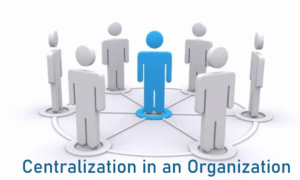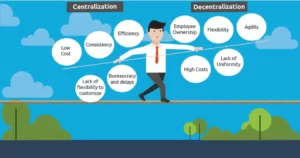There’s no doubt that there’s a tendency for startups and medium scale companies to centralise out-of-the-norm (but day-to-day) decision making to the top management. Management approvals are mandatory before even a response is given to a ‘new’ situation.
Without a doubt, decisions have an impact on the company. Whether they are taken by top management or by ground troops. And since the ‘buck stops at the top’ the common (note I don’t say natural!) organisational behaviour is to say ‘pass it by me’ before making any commitments or decisions. The Yanks say “it’s above my pay grade”.
Centralised command and control yields low employee morale, higher employee turnover and often lower performance levels of the ground troops.
Centralization results in delays in work as records are sent to and from the head office. Employees rely on the information communicated to them from the top, and there will be a loss in man-hours if there are delays in relaying the records. This means that the employees will be less productive and more frustrated if they need to wait long periods to get guidance on their next projects.
Employees become loyal to an organization when they are allowed personal initiatives in the work they do. They can introduce their creativity and suggest ways of performing certain tasks. However, in centralization, there is no initiative in work because employees perform tasks conceptualized by top executives. This limits their creativity and loyalty to the organization due to the rigidity of the work.
The organization’s executives are under tremendous pressure to formulate decisions for the organization, and they lack control over the implementation process. The failure of executives to decentralize the decision-making process adds a lot of work to their desks.
The top executives suffer from a lack of time to supervise the implementation of the decisions. This leads to reluctance on the part of employees. Therefore, the executives may end up making too many decisions that are either poorly implemented or ignored by the employees.
Centralized management resembles a dictatorial form of leadership where employees are only expected to deliver results according to what the top executives assign them. Employees are unable to contribute to the decision-making process of the organization, and they are merely implementers of decisions made at a higher level.
When the employees face difficulties in implementing some of the decisions, the executives will not understand because they are only decision-makers and not implementers of the decisions. The result of such actions is a decline in performance because the employees lack the motivation to implement decisions taken by top-level managers without the input of lower-level employees.

CXOs often wonder how do they ‘balance’ the “risks” of delegating power commensurate with delegated responsibilities. This question nags every top management team aspiring for high perfomance on the ground.
Let’s go very briefly beyond the overt ‘facts’.
Why do CXOs make better decisions? Almost all of them would have gone through the grind climbing up the corporate ladder, learning dos & donts along the way, especially how to ‘save’ their seats and prospective careers. Consequently, those few who do rise to top management, have changed their natural behaviours by force of survival necessity. However their core character doesn’t always change. And that surfaces at the most extreme circumstances, sometimes leading to disaster.
Dos and donts are rules. Black & White. Authoritarian. With attached consequences (whether graded/progressive or not) for infringements of these rules. Given *all* situations cannot possibly be visualised in advance to frame rules for every concievable situation.
Life does not flow in black & white only. There’s the a huge grey area between the two. And there lies the real challenge for organisations and CXOs. Nevermind that they too are actually ‘victims’ of the same inadequacies!
This where rules fail. Utterly fail. And tend completely towards centralisation. Or, worse, to ‘collective’ responsibility aka committees.
Failure is manifest as a ‘gap’ between top management aspirations and vision on the one hand and ground reality on the other.
I’m not saying there ought to be no rules and regulations! Basic rules are obviously needed. These will ‘naturally’ be constantly improved and evolve as the company matures. Unfortunately, even basic rules will only operate in the white-black spectrum. But that’s a price to pay for the stability of the company. It also means the ‘gap’ has started appearing!
So where does the solution to reducing this ‘gap’ lie? Obviously, it lies in empowerment of ground forces.

After all, they are the nones who actually deliver the company’s vision and aspirations on the ground. They are the people who ‘face Life’ moment to moment. And as I said, atleast some of it is in the grey area, outside the appropriateness of rules and regulations.
Empowerment is not just delegating authority. With inherrent character of the junior officer, more authority won’t widen his or her’s mental vision. S/he will still lack the worldly experience of those in the C-Suites. So whether delegating authority alone will be sufficient to reduce the ‘gap’ is a moot point.
Empowerment has to be internal to the person and at the level of each individual (one by one) in the ground force. Since it is individual, each person must actually *want* to change his/her character. Therein lies the stumbling block in corporate ‘training’ plans. I am not referring to ‘training’ that focusses on processes and rules/regulations that are actually in the realm of induction training.
Psychology will tell us whats ‘wrong’ and treatment is painfully slow and expensive. It won’t bring about a change in organisational behaviour. Especially the large numbers in the ground force.
Philosophy will help in ‘accepting’ the consequences of non-performance. But won’t change organisational behaviour either.
This where Ontological Trainings with large groups can come to the rescue. Ontology will work at the individual level but can be done with large groups. It lends itself to “training” of a large number of critical ground force officers who operate with even larger number of boots on the ground.
There’s an old management adage: The personality of the top leader pervades the whole organistion. It shapes the future of the company. The ground forces are only following orders.
Minimising the ‘gap’ between a company’s vision and aspirations needs to start with the CXO suite, moving downwards…. even to the boots on the ground. Done in the reverse direction will only increase frustrations and employee turnover in the ground forces.
Tw: @jsvasan

